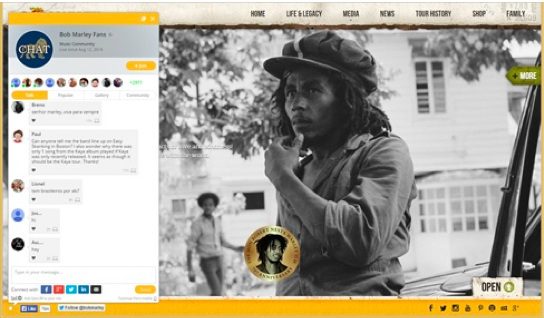This is a guest contribution from Ben Shwartz.
They say you shouldn’t judge a book by its cover… but does that extend to eBooks? How about webpages? In the current state of our globalized, media-saturated society, it’s difficult—if not outright impossible—to live by this seemingly antiquated adage. Amidst the hustle and bustle of the World Wide Web, appearance often conquers content in terms of user retention, which makes your landing page the golden ticket to your website’s success.
“If you had one shot, one opportunity to seize everything you ever wanted, one moment… would you capture it, or just let it slip?”—Eminem on landing page optimization… or a rap battle.
Generating a home page with interactive features (think layered multimedia and on-site social networking) allows the fireworks to come directly to the customer, instead of having the customer waste his or her precious time searching for what exactly it is that you have to offer. With that said, put your best foot forward and take advantage of all the…well, advantages, an interactive site can procure.
Capture the social media-unfriendly.
For better or for worse, social media often gets a bad rap. For the stubborn old-timers, social media shy, and those who are proud to have never given a virtual thumbs-up or double-tapped to “like,” having an on-site source for communication can be an easy (and potentially covert) transition to get these hesitant folks more inclined to digital networking.
If you’ve already won the first battle by getting them to your site in the first place, the immediate presence of focused content and engaging topics relevant to their interests may compel them to take part in the conversation. Easy, automatic signup options (i.e. via your email account) saves time and gets the user directly apart of the conversation. As a bonus, user profiles are limited within the site’s perimeters, ensuring an extra level of privacy that will be happily received by any reluctant recluse.
For the sake of organization.
If you’re a startup or an e-commerce retailer, chances are you have a string of social media accounts representing your business all around the web. From obvious mainstays like Facebook and Twitter to the more professional LinkedIn and less structurally restrictive Tumblr, there’s a whole pond full of big name outlets for one little fish to navigate. Streamline key topics of interest to establish your site as the primary source of discussion, so as to provide a clear, exact, and timely authority on your site’s content. Allow your social media links to direct traffic back to your site, whether they target new customers with catchy captions or retain existing customers with reminders regarding updates to the content with which they are already familiar.
On the contrary, if you’re looking to give your customers some extra context that you find may interest them (and thus further establish yourself as a thought leader), multimedia tools are available on the market to create centralized hubs of outsourced interaction. Simple, customizable icons link to related and relevant content. Should one recommendation prove beneficial to your customer, there’s a good chance you’ve converted him or her into a repeat user on your own site.
Enjoy the benefits of live personal presence in real-time.
Social networking, especially within a particular niche, can quickly get to look a lot like a high school cafeteria. You have a few cheerleaders on the hunt for prom dresses, a gaggle of brainiacs preparing for the next Comic-Con, and devoted group of traveling Phish fans. While each individual adheres to a different class schedule, eating at the lunch table affords a precious punctual platform from which to vocalize their hopes, needs, and desires.
While these “lunch tables,” or online outlets for communication, do currently exist (and in great numbers), the current state of cyber affairs stimulates the desire for instant gratification, or feedback in real-time. While alerts and notifications on other outlets can remind you of existing conversations, having an on-site communication tool allows a more organic flow of communication. Customers can feel that they’re actually a part of a dynamic conversation, rather than uttering anonymous nothings to the wind. Users can create more substantial relationships with one another and in turn, return to the site to continue these budding interest-based friendships. Topics will be more likely to stay on course given their placement in a centralized, authoritative position, and you will be more likely to sustain P2P relationships given that your site will be the common link (literally) shared between viewers. Just like in high school, everyone wants to be a part of a group and their conversation. Your on-site social network will give your viewer a voice and heighten the likelihood that he or she will be heard.
Educate others while educating yourself.
In terms of building a community, user retention is more likely to increase if your viewers feel at home. If they’re already engaging in a conversation, they’re more likely to resume input if they feel that they’re in a group consisting of thoughtful peers based on mutual interests and respect.
Having one (or several) of your team members as an active social presence on your site is a win-win for all parties. From a customer’s perspective, they can gain insight from interaction with a thought leader, and the informal setting in which it takes provides a more humanized and less formal or mechanical component.
Additionally, it goes without saying that a business needs to determine its customers’ desires and interests, and having an inside source on the front lines is one of the easiest ways to do just that. By learning the popular topics in your forums, you’ll have a better idea of what can be added, edited, or removed to maximize your website’s potential and propel your future business goals.
In essence, an interactive website prioritizes and centralizes not only the products by also the discourse associated with your brand. Your landing page is your money maker, given its status as your company’s official authority. If we stay with the times and realize that consumers must be efficiently engaged to ensure conversion, then we must recognize how important it is to create a visually appealing product that provides a one-stop shop for your audience’s needs.
Finally, consumers strive for a human connection rather than a technical, formalized response to their social networking input. Combine winning visuals with interactive, informal discussions to ensure that your site is one worth reading from one day to the next.
Ben Shwartz is the VP of Marketing for Spot.IM. He loves to buy and sell websites, and immerse himself in anything and everything in the realm of online marketing.
Originally at: Blog Tips at ProBlogger
Why Should I Make My Webpage Interactive?


